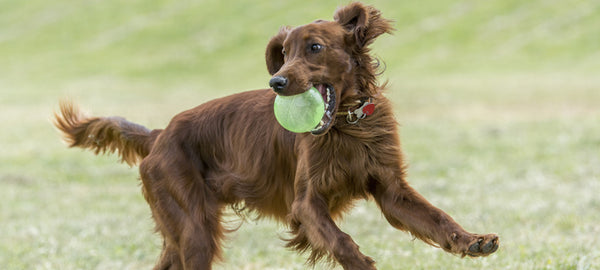Healthy joints make a happy dog

Dogs are at their happiest when they are running, playing, jumping and chasing balls- getting up to all sorts of mischief.
They bring out the best in people and seem to have endless amounts of energy, most of the time tiring their owners out before themselves.
Have you ever thought about the impact all of this playing has on your dog's joints?
When dogs are playing they pay no attention to their body telling them that they need rest, they will often carry on until you decide play time is over. As with humans, over time the body suffers wear and tear, particularly joints, resulting in stiffness and other joint problems. Stiffness or pain can occur at any time in your dog's life, but it is generally more common in the older dog.
Know the signs
Limping and stiffness
As dogs get older they can become slightly stiff due to inflammation in their hip, knee and other leg joints. Gradual wear and tear from every day movement can lead to the development of some stiffness and in turn may progress to limping.
When limping occurs, it is most likely to be as a protection mechanism, as they avoid putting weight on the joint, thereby minimising pain. Limping can cause your dog to overbalance and slip, particularly on smooth surfaces such as tiled or laminated floor. If your dog is suffering joint pain they may exhibit behaviours such as continually licking or even chewing the area that is causing them discomfort.
Muscular atrophy
When a dog is happy and healthy they are always on the move. A dog suffering from joint pain will move less to avoid potential pain. There may also be a reduced range of movement as the joint stiffens. As such muscles are at risk of atrophy (wasting away) as they are not being used as much as before. This can happen surprisingly quickly, especially in an older dog, and is a visible effect of pain.
Preventing and easing joint pain
If your dog is displaying any of the above symptoms, it is important to take action to help slow progression of disease and reduce the associated pain. If you're concerned, talk to your vet.
There are many ways to keep your dog's joints healthy and young from an early age, helping to prevent or delay problems as they get older.
Regular exercise
Regular exercise contributes significantly to the longevity of your dog's health, playing a considerable role in physical and mental well being.
Puppies do not need as much exercise, as a rule of thumb a good ratio is five minutes of exercise per month of age (up to twice a day) until they are fully grown, for example if your puppy is 3 months old, you would walk for 15 minutes twice a day. This is because over exercising a growing puppy can overtire and damage developing joints. However it is important to get them out as young dogs will benefit from short walks and training sessions for their physical and mental development. Avoid encouraging lots of jumping and jerky movements until their bodies have matured.
As your dog gets older or they start to demonstrate mobility issues, you can respond with some simple adaptations to their exercise routine.
One activity that allows your dog to exercise without having to put pressure on their joints is swimming or hydrotherapy. This is a great way for them to exercise and build muscle without causing pain to the joints.
Adapt your regular exercise regime but consider the terrain, speed and movement. Walking on even ground, perhaps keeping them on a lead at times to reduce running and jumping will help to keep your pet as comfortable as possible.
Play with your dog to release some energy and rest when they need it, but try to make sure you stay low to the ground to avoid extreme movements as this can aggravate stiff joints.
Weight management
Weight gain in dogs can put a lot of stress on joints and lead to inflammation and in turn pain. If you notice that your dog has put on weight, consider putting them on a weight management routine to include appropriate diet and light exercise.
Supplements & Diet
Introducing a joint supplement into your dog's diet can help reduce stiffness of the joint by repairing cartilage and smooth wear and tear. ProJoint for Dogs is a palatable, easy to feed joint supplement to help maintain healthy joint function. Carefully researched and developed ProJoint for Dogs is an innovative, specially formulated supplement with 14 key ingredients to maintain free movement of the joints in all breeds and ages of dog. ProJoint for Dogs includes Glucosamine, a natural polymer that ensures mobility and elasticity, as well as omega 3 for health and vitality. Beta-glucans help gut wall function and aid immunity, and is supplemented with other ingredients to support growing, ageing and active dogs.
Preventing and managing joint problems in your dog requires a holistic approach. ProJoint for Dogs can be used from an early stage to help aid healthy joints whilst your dog is developing, or to manage joint problems in the older dog.
